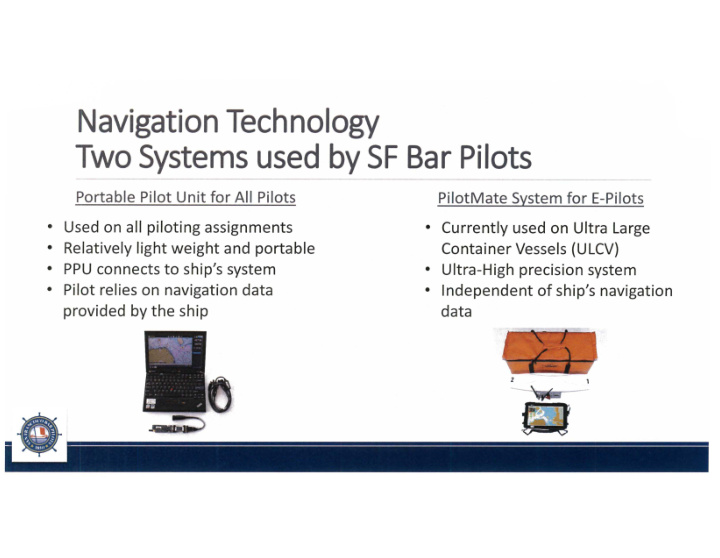



~ ~ ~ ~ Navigation Technology Two Systems used by SF Bar Pilots Portable Pilot Unit for All Pilots PilotMate System for E-Pilots • Used on all piloting assignments • Currently used on Ultra Large • Relatively light weight and portable Container Vessels (ULCV) • PPU connects to ship's system • Ultra-High precision system • Pilot relies on navigation data • Independent of ship's navigation provided by the ship data ' ·.,:,ii'::-. ~:.~ . ..-.:..'. 2 E ~ •
ULCV Passage Feasibility and Assessment for Oakland SFBP participated in a study with the Port of Oakland to New Panamax (NX) and determine if ULCV class vessels could safely call on the port Ul tr a Large Container Ve ssel (ULCV) Passage Feasibility & Assessment Prepared for Extensive simulations and review determined the The Port of Oakland following recommendations: • Utilize Precision Docking Systems • Assign an E-Pilot Filit trt e: nlfl110, ~MIi o ·• CAL MARITIME • Additional operational guidelines TowtngSoMkWla -:.:..~-=
E-Pilot The E-Pilot is a second pilot assigned to the vessel to assist the Primary Pilot with maneuvering a ULCV class vessel in and out Oakland During the movement of the vessel the E-Pilot provides the Primary Pilot with navigational data from the PilotMate Precision Docking System including, (but not limited to) course, speed, position, rate of turn, set and drift as well as predictions of the ship's path ~ •
PilotMate Precision Docking System Operates completely independent of ship's navigation system - ..... -L..-~~-.r ~ __ ,:• ~ ' PilotMate provides the pilot with: • Sub-Meter position accuracy • Precise speed in all directions • Stable heading and orientation • Rate of turn and predicted path • Distance to obstructions - •
PilotMate System Cost Current PilotMate equipment in use: Next Generation Precision Docking System: • $72,000 equipment • $100,000 - $200,000 equipment • $3,000 - $6,000 annual • Similar estimated annual maintenance maintenance and updates and update expense 2 to 3 years remaining service life I • • 5 years service life 111111!
Portable Pilot Unit California Regulatory Requirements California Code of Regulations, Title 7, Section 219 (y) requires S.F. Bar Pilots to be equipped with a PPU unless its carriage creates an unacceptable safety hazard. The PPU must have the ability to display electronic charts, position, heading and other navigational information ~• provided by a ship's pilot plug.
Portable Pilot Unit (PPU) • A portable computer system that a pilot brings onboard a vessel to use as a decision-support tool for navigating in confined waters • Interfaced to ship's positioning sensors such as GPS/DGPS and using an electronic chart display, it shows the vessel's position and movement in real-time • PPU's provide information about the location/movement of other vessels via an Automated Identification System (AIS) interface
Standard PPU Limitations • The PPU is reliant on vessel's pilot plug data only. This data is not always accurate • Pilot does not know the position quality, GPS smoothing rate, or antenna offset configuration of ship he/she is piloting • The AIS pilot plug may not provide accurate Rate of Turn (ROT) data for advanced PPU software to provide the pilot with an accurate display of vessel predicted path 11111!11
Common AIS Pilot Plug Errors: Ship data is not always accurate data -- . -~:.: .. :_:; .::.: : ~> '. : .. r :: :· ··. The AIS Pilot Plug provides the PPU Incorrect pilot ~-<::·:··::::;:\()( with position and dimensions of plug position data . :.::· ::: ..... ~ :.· .... : - ~ the vessel, as well as the ···:- -~·· .,.,, . ,_,__,, .. ·I configuration of the GPS receiver Vessels data may have incorrect dimensions and configuration which give the pilot false vessel Actual ship's positions position
Common AIS Pilot Plug Errors: Ship data is not always accurate data The AIS Pilot Plug provides the PPU Incorrect pilot with position and dimensions of plug position data 1 ... : ·: the vessel, as well as the configuration of the GPS receiver Vessels data may have incorrect dimensions and configuration ..... ,, .... ,,,, .... ' ... which give the pilot false vessel Actual ship's positions position .• ,
Common AIS Pilot Plug Errors: GPS Smoothing Ship's GPS sensors apply a method of averaging to the course and speed data {Smoothing) supplied to the pilot's PPU vessel's predicted positions Incorrect smoothing intervals can generate false vessel path predictions vessel's actual ~ •
Common AIS Pilot Plug Limitations: Rate of Turn (ROT) Data No ROT data from Precision ROT data with 30 AIS Pilot Plug second predicted path display !!!I!
~ ~ - - Q) V') :J 0 - ..c Q) Q) ::::> ..c s a.. C: a.. Q) > ro -0 a:: Q) u C ro ..c:: C UJ C 0 ·- +-' V') :J Q) e..o <C C E Q) l!) ro z >< Q) z
Next Generation Enhanced PPU Components • Laptop or Tablet with PPU software • Configured to work with independent sensors • Utilizes only heading and other vessel AIS data from ship's pilot plug • Precision, lightweight portable Differential GPS {DGPS) • Independent of ship's GPS • Pilot calculates proper antenna offsets • Proper data smoothing rate for use while piloting • Rate of Turn Generator (ROTG) • Solid state, precision device that provides the PPU with instant, ~ • accurate Rate of Turn {ROT) data for vessel path prediction
Next generation PPU benefits Increased Safety due to: • Independent precision GPS receiver • Pilot control of correct GPS configuration • Accurate Rate of Turn data • Enhanced restricted visibility navigation with predicted vessel path ~ •
Recommend
More recommend